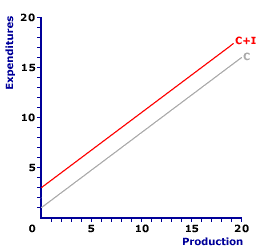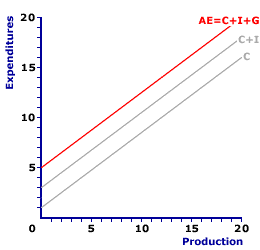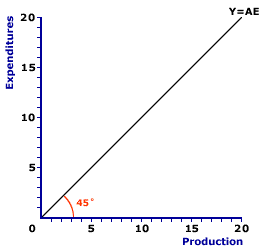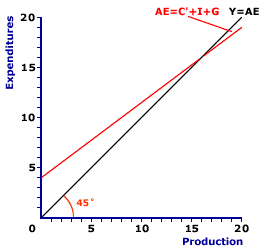
|
|
MARGINAL UTILITY AND DEMAND: An explanation of the law of demand and the negatively-sloped demand curve can be found in the analysis of marginal utility and especially the law of diminishing marginal utility. This explanation rests on two propositions. One, the law of diminishing marginal utility means that the marginal utility obtained from consuming a good declines as the quantity consumed increases. Two, the marginal utility of a good underlies the demand price that buyers are willing and able to pay for a good. When combined, these two propositions indicate that the demand price buyers are willing and able to pay for a good declines as the quantity demanded (and consumed) increases. And this is the law of demand.
Visit the GLOSS*arama
|
|


|

|
                           THREE-SECTOR KEYNESIAN MODEL: A Keynesian model of the macroeconomy that includes the three domestic sectors, the household sector, the business sector, and the government sector. This Keynesian model variation adds the government sector (or public sector) to the household and business sectors that make up the two-sector model. This model enables an analysis of government stabilization policies, especially how fiscal policy changes in government purchases and taxes can be used to close recessionary gaps and inflationary gaps. Equilibrium is identified as the intersection between the C + I + G line and the 45-degree line. Two related models are the two-sector Keynesian model and the four-sector Keynesian model. The three-sector Keynesian model is perhaps the most commonly used representation of Keynesian economics. It contains the three essential components of the macroeconomy needed to analyze business-cycle instability.The Public SectorThe three-sector Keynesian model adds the government sector to the two-sector model containing only the household and business sectors. In other words, it includes the public sector in Keynesian analysis.The public sector is another term for the government sector, the sector that forces involuntary resource allocation decisions on the rest of the economy through laws, rules, and regulations. The public sector enters this model in two ways--by adding government purchases to aggregate expenditures and by subtracting taxes from aggregate expenditures. Whichever term is used, government takes center stage in Keynesian economics as the means of correcting business-cycle instability. For example, the decline in business sector investment that would move the economy toward a contraction, can be countered by an increase in government sector purchases or a decrease in taxes. Aggregate Expenditures: The C + I + G Line| C + I + G Line | 
|
The first step to adding government to the two-sector Keynesian model is relatively easy. Government purchases are merely one more layer added to the aggregate expenditures stack that includes consumption and investment. Let's derive the aggregate expenditures line for the three-sector Keynesian model.- This diagram displays the consumption and investment layers that make up the two-sector aggregate expenditures line. The consumption line is labeled C and the combination of consumption and investment is labeled C + I. Because investment is assumed to be autonomous, both lines have slopes equal to the marginal propensity to consume.
- The three-sector Keynesian model is commonly constructed assuming that government purchases are also autonomous. While this is not particularly realistic, it does enable a number of important conclusions about the government sector without overly complicating the analysis.
- Adding the government sector to the C + I line is a simple matter of adding a fixed amount of government purchased to each level of aggregate production. You can display this three-sector aggregate expenditures line by clicking the [Add Government] button. The resulting line is labeled AE = C + I + G.
Because government purchases (as well as investment) are autonomous, the slope of the AE = C + I + G is parallel to the consumption line (C) and the C + I line. All three lines have the same slope equal to the marginal propensity to consume.If induced government purchases are used rather than autonomous government purchases, then the slope of the line is equal to the marginal propensity to consume plus the marginal propensity for government purchases. This would make the AE = C + I + G line steeper than the consumption line. Aggregate Expenditures: Subtracting Taxes| Subtracting Taxes | 
|
The government sector not only contributes to aggregate expenditures through government purchases, it takes away from aggregate expenditures by imposing taxes. Taxes reduce income which, at the very least, reduces consumption.The exhibit to the immediate right illustrates the three-sector aggregate expenditures line containing C, I, and G. Including taxes in this model means less income is available for spending by the two private sectors, in particular, consumption by the household sector. In effect, the inclusion of taxes causes the aggregate expenditures line to shift down a bit. While it might seem that the reduction of aggregate expenditures caused by taxes would exactly offset the increase in aggregate expenditures caused by government purchases, such is not the case. Even if taxes are equal to government purchases (which is not necessarily the case), the aggregate expenditures line does not shift down by the same vertical distance as the size of the G layer of government purchases. The reason is that taxes do not decrease consumption dollar for dollar. Because changes in income affect both consumption and taxes, a portion of taxes also comes out of reduced saving. To see how the inclusion of taxes causes the AE = C + I + G line to shift down, click the [Adjust for Taxes] button. The resulting aggregate expenditures line is labeled AE' = C + I + G. Once again, to keep the analysis simple, taxes are assumed to be autonomous. If the adjustment is made with induced taxes, then the slope fo the aggregate expenditures line would change. An Equilibrium Guide: The 45-Degree Line| 45-Degree Line |  |
The equilibrium guide line is a 45-degree line that bisects the 90-degree angle formed by the horizontal and vertical axes. The exhibit to the right presents a 45-degree line. Careful measurement of the angle between this line and either the vertical axis or the horizontal axis should confirm a value of 45 degrees.The most important feature of the 45-degree line is that it contains every point in the diagram in which aggregate production is equal to aggregate expenditures. In other words, if you pick an aggregate production value, such as $5 trillion, move vertically to the 45-degree line, then take a right turn to the vertical axis, you reach an equal $5 trillion value for aggregate expenditures. Because this 45-degree line contains EVERY potential equilibrium value for the three-sector Keynesian model, equilibrium MUST take place somewhere ON this line. Exactly where equilibrium occurs, however, depends on the aggregate expenditures line. We often find it convenient to give this guide line the label of Y = AE, where Y is the common designation for aggregate production and AE is the abbreviation for aggregate expenditures. Such a label descriptively indicates that this is, in fact, the equilibrium guide line for the Keynesian model. The Equilibrium Intersection| Equilibrium | 
|
The parts needed to identify equilibrium for the three-sector Keynesian model are now in place. To identify equilibrium, consider the exhibit at the right.Equilibrium is achieved at the intersection of the 45-degree line and the aggregate expenditures line. Click the [Equilibrium] button to identify this point and corresponding aggregate production. - Equilibrium is achieved with $16 trillion of aggregate production. At this level, aggregate expenditures are also $16 trillion.
- Only at $16 trillion are aggregate expenditures equal to aggregate production. At every other production level, aggregate expenditures are either greater than or less than aggregate production.
- At this $16 trillion level, there are no economy-wide surpluses or shortages because buyers buy all they want and sellers sell all they have.
- The lack of surpluses and shortages means that we have equilibrium. Neither buyers nor sellers are dissatisfied with this condition, and thus have no reason to alter the production level.
- A key indicator of this equilibrium is business inventories -- stockpiles of raw materials and finished goods. The business sector has no unexpected, or unplanned, changes in inventories.
Two Other VariationsThe three-sector Keynesian model Keynesian model is one of three common variations. The other two models rely on different combinations of the four macroeconomic sectors.- Two-Sector Model: The simplest Keynesian model includes the household and business sectors. Also termed the private sector Keynesian model, this variation is often used to illustrate the basic operation of the model, including adjustment to equilibrium and the multiplier process. The two-sector model captures the role of induced expenditures through household consumption and the role of autonomous expenditures through business investment.
- Four-Sector Model: As the name suggests, all four macroeconomic sectors--household, business, government, and foreign--are included in the four-sector Keynesian model. This model is not only used to capture the interaction between the domestic economic and the foreign sector, but also provides the foundation for detailed, empirically estimated models of the macroeconomy.

Recommended Citation:THREE-SECTOR KEYNESIAN MODEL, AmosWEB Encyclonomic WEB*pedia, http://www.AmosWEB.com, AmosWEB LLC, 2000-2025. [Accessed: July 18, 2025].
Check Out These Related Terms... | | | | | | | | | | |
Or For A Little Background... | | | | | | | | | | | | | | | | | | | |
And For Further Study... | | | | | | | | | | | |
Search Again?
Back to the WEB*pedia
|



|

|
GRAY SKITTERY
[What's This?]
Today, you are likely to spend a great deal of time driving to a factory outlet wanting to buy either a coffee cup commemorating yesterday or a replacement remote control for your television. Be on the lookout for a thesaurus filled with typos.
Your Complete Scope
This isn't me! What am I?
|

|
|
The word "fiscal" is derived from a Latin word meaning "moneybag."
|

|
|
"A winner is someone who recognizes his God-given talents, works his tail off to develop them into skills, and uses those skills to accomplish his goals. " -- Larry Bird, basketball player
|

|
WAPM
Weak Axiom of Profit Maximization
|

|
|
Tell us what you think about AmosWEB. Like what you see? Have suggestions for improvements? Let us know. Click the User Feedback link.
User Feedback
|


|


